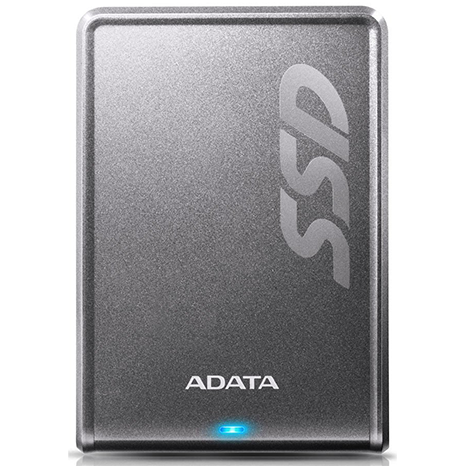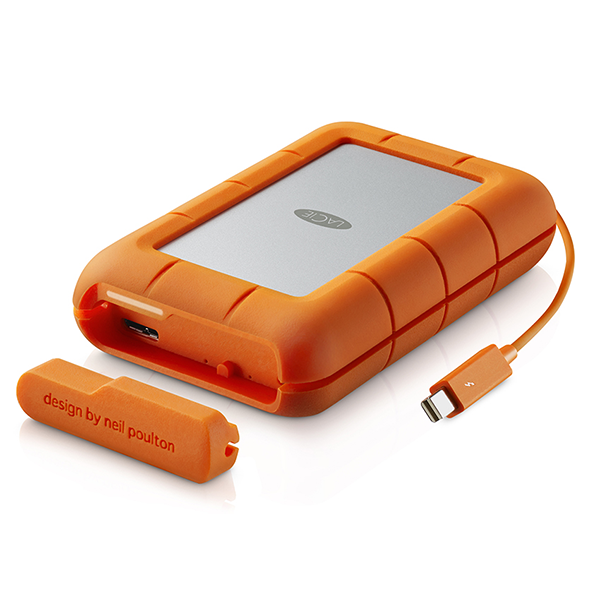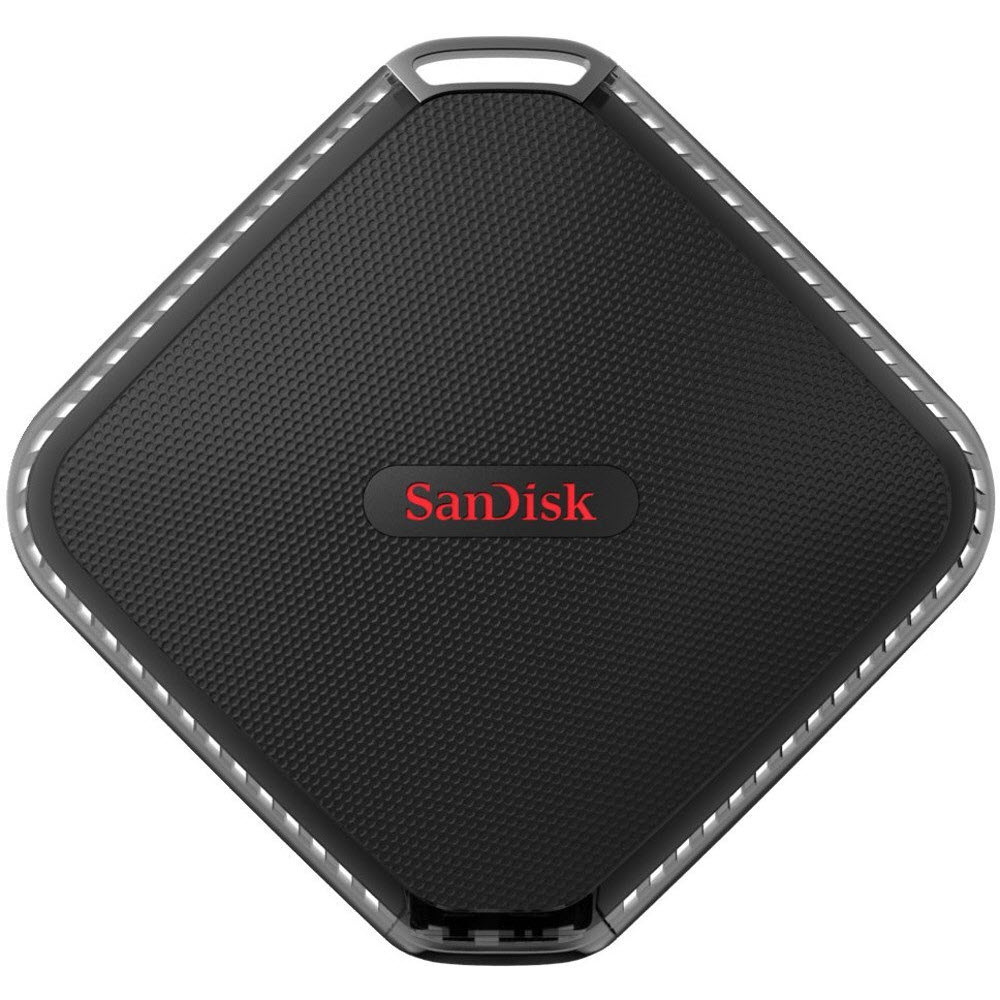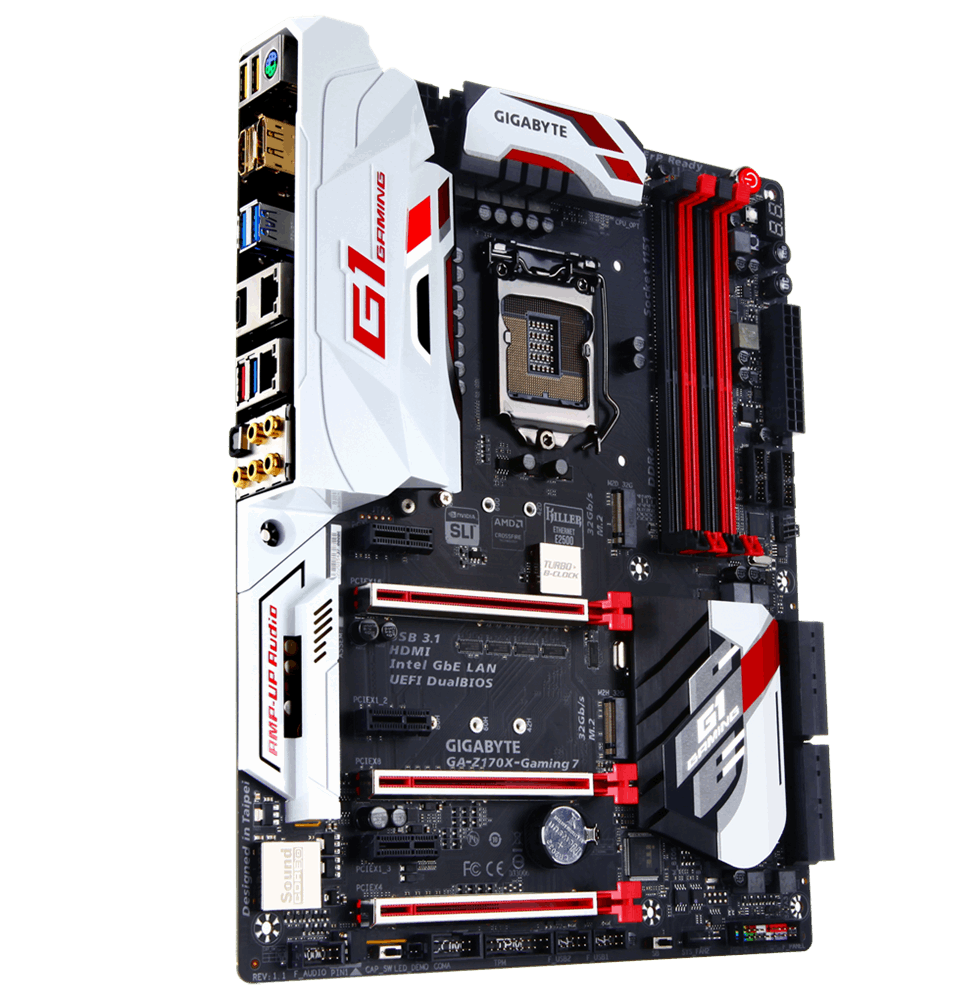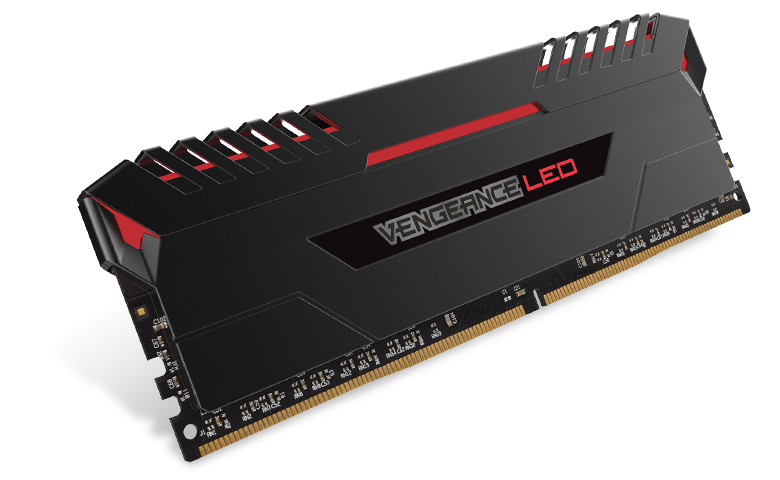Adata SD700 Portable SSD Review
Why you can trust Tom's Hardware
Performance Testing And Conclusion
Comparison Products
We included four other portable products in our test pool. The SanDisk Extreme 500 Portable 240GB and Extreme 510 Portable 480GB are other flash-based rugged storage solutions that fit easily into your pocket and take on a less-than-traditional shape. SanDisk also lists the Extreme as IP-qualified dust and splash resistant.
The Seagate Backup Plus Ultra Slim 2TB's selling price is slightly less than the three Adata flash-based products, and it offers a big capacity increase. The internal HDD makes it more susceptible to falls, and it lacks the ability to blast through random data with the same speed as an SSD.
The LaCie Rugged RAID 4TB is the HDD vendor's way of competing with SSDs in performance and ruggedness. The drive features Thunderbolt 2 and USB 3.0 5Gb/s connections and two internal 2TB HDDs melded together into either RAID 1 or RAID 0. The external case and internal shock system increase the Rugged RAID's sustainability in a fall. The extra components add to the cost; expect to spend around $400 thanks to the expensive Thunderbolt component.
We tested the Adata SV620 480GB in an Adata portable SSD roundup. The SV620 features a desktop SSD inside, just like the two SanDisk Extreme 5x0 Portables.
Test Environment
We began using a new test system several months back. We changed the test system to test Thunderbolt 3, USB 3.0 Gen 2 and USB Type-C connected devices. The versatile Gigabyte GA-Z170X-Gaming 7 motherboard is the heart of the new external storage test system and comes equipped with certified Thunderbolt 3 that delivers up to 40 Gb/s (32Gb/s of data with 8Gb/s of video). The motherboard was also the first to incorporate Intel's latest USB 3.1 controller that connects to the host via PCI Express 3.0 x4 for unrestricted external storage performance. Without shame, we can say this is one of, if not the best, motherboard for testing external storage devices without data path restrictions. The LED backlit IO panel helps when we connect external devices.
The new Z170 platform required a new CPU and memory. Intel sent a flagship Core i7-6700K that we run at 4.5GHz with a Noctua NH-U9S. The new platform also required new memory, so Corsair supplied us with high-speed Vengeance LED DDR4 memory. The red LEDs help to light up our rackmount test environment. The memory was a vital component needed to create a stable overclocked system that can deliver bottleneck-free repeatable test data.
Sequential Scaling

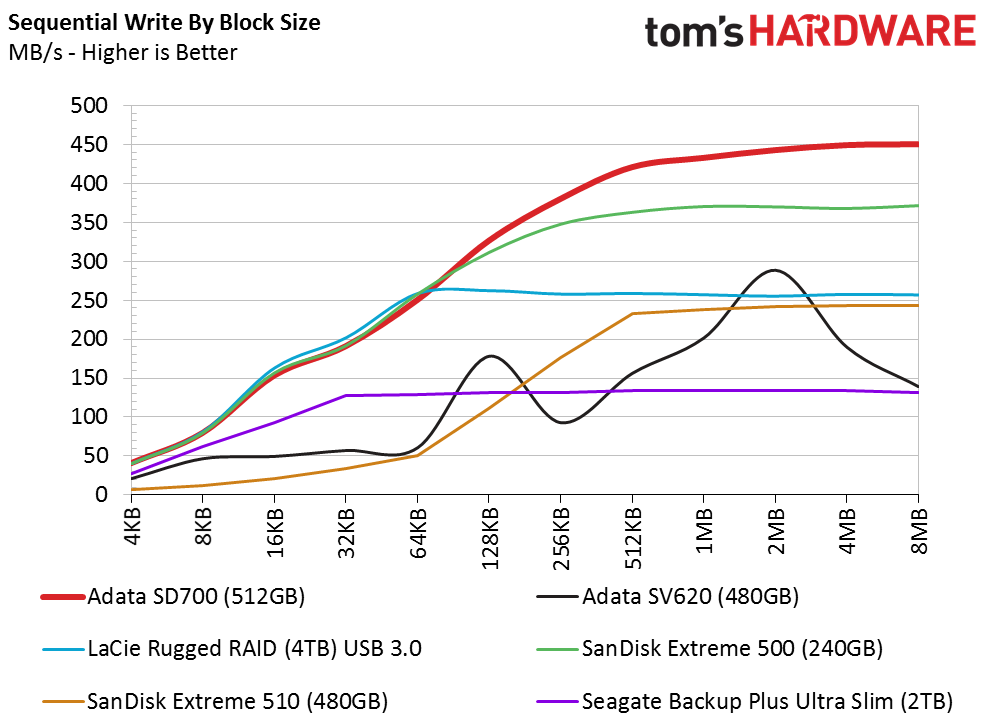
The transfer tests measure how fast a product can move specific sizes of data. Windows will move small blocks up to 128KB. The operating system separates data that is larger than 128KB into two or more blocks, which increases the queue depth. The term sequential comes into play when the operating system reads or writes a large file in a linear fashion. The system knows where the next chunk of data is and how it will proceed because the data isn't placed randomly on the drive.
Get Tom's Hardware's best news and in-depth reviews, straight to your inbox.
The Adata SD700 that we have under the microscope is the only product of the six to deliver 450 MB/s of sequential read and write performance. The highest performance comes with large blocks. The 128KB transfers occur at roughly 300 MB/s and, as expected, performance decreases with smaller blocks.
Full LBA Span Performance
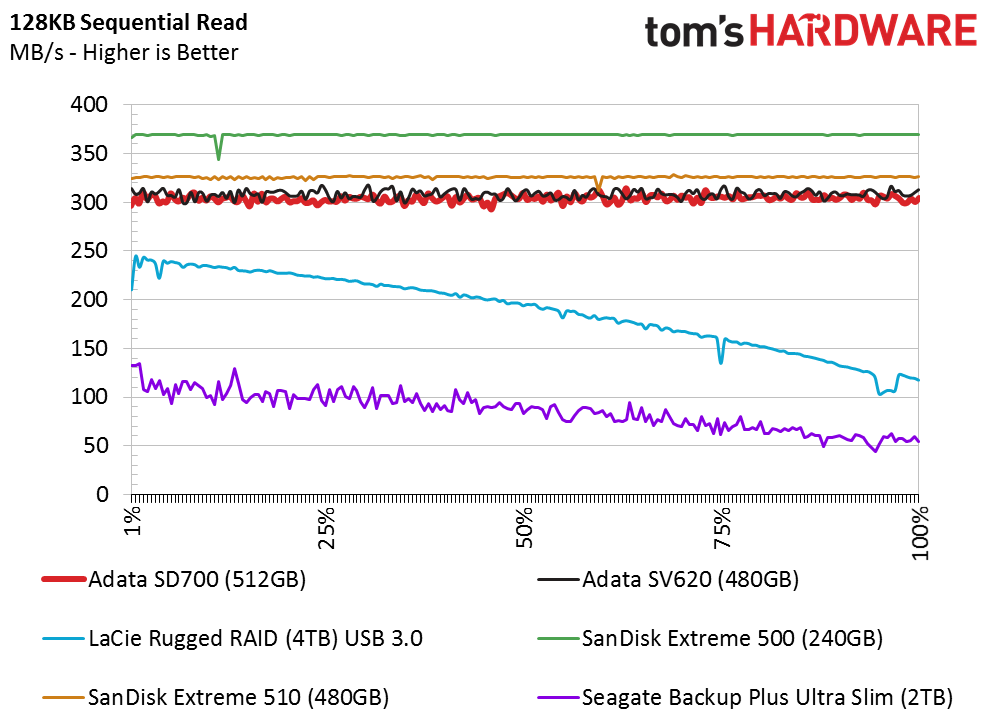
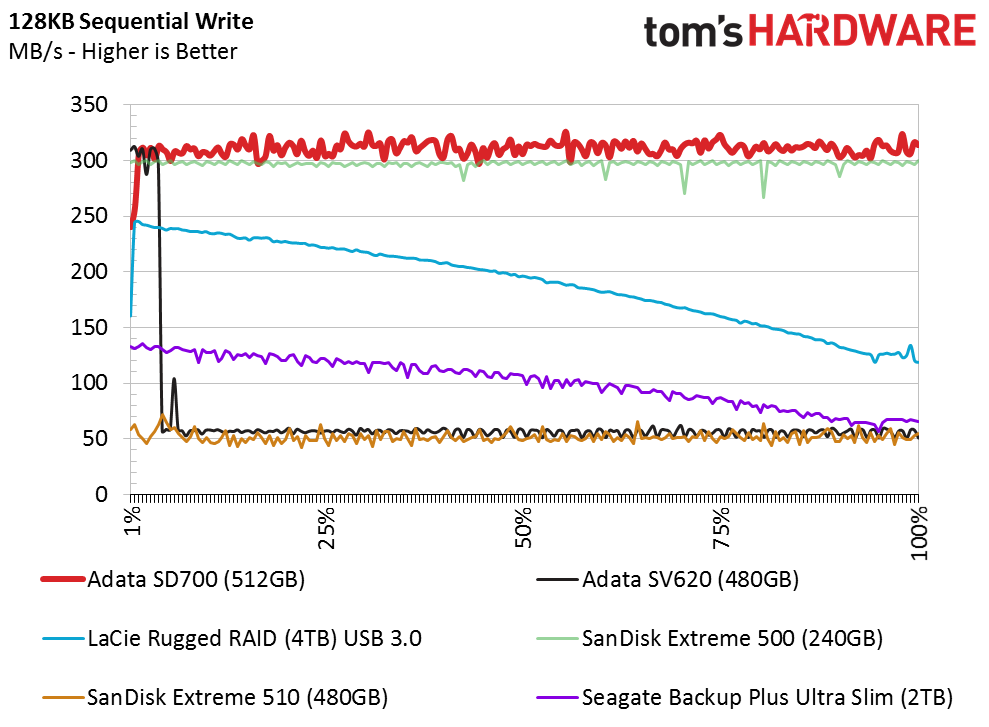
In these tests, we read and write 128KB sequential data across the entire available space of the target storage device. The Adata SD700 delivers consistent performance for a product utilizing 3-bit per cell (TLC) NAND flash. The USAP protocol supports the TRIM command, so you can expect performance to remain high if the drive has some idle time after you delete data.
File Transfers
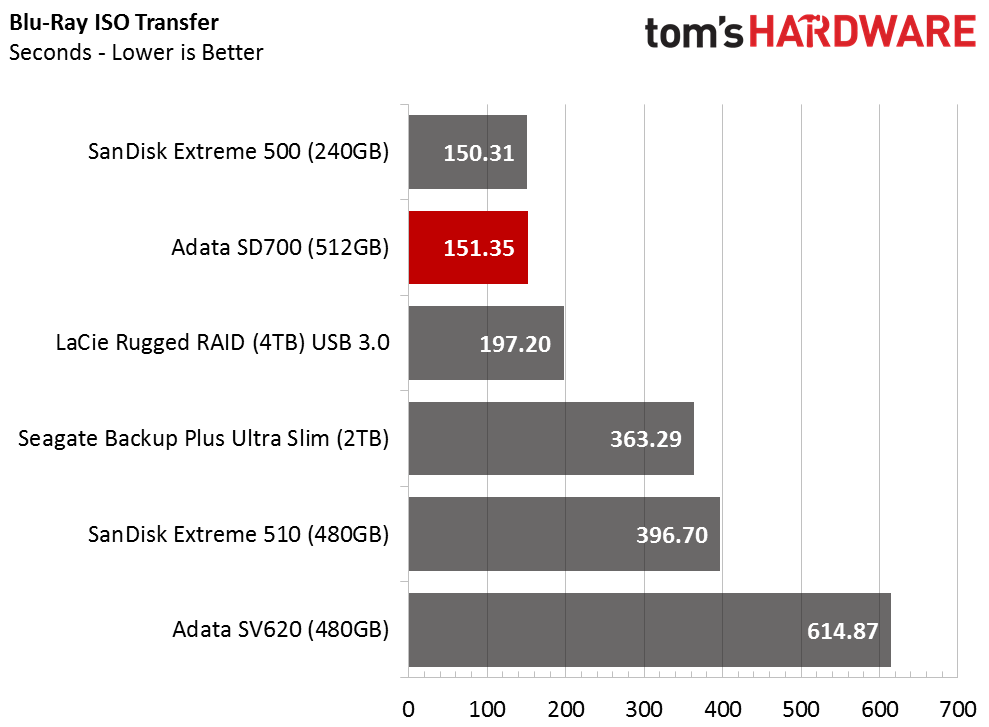
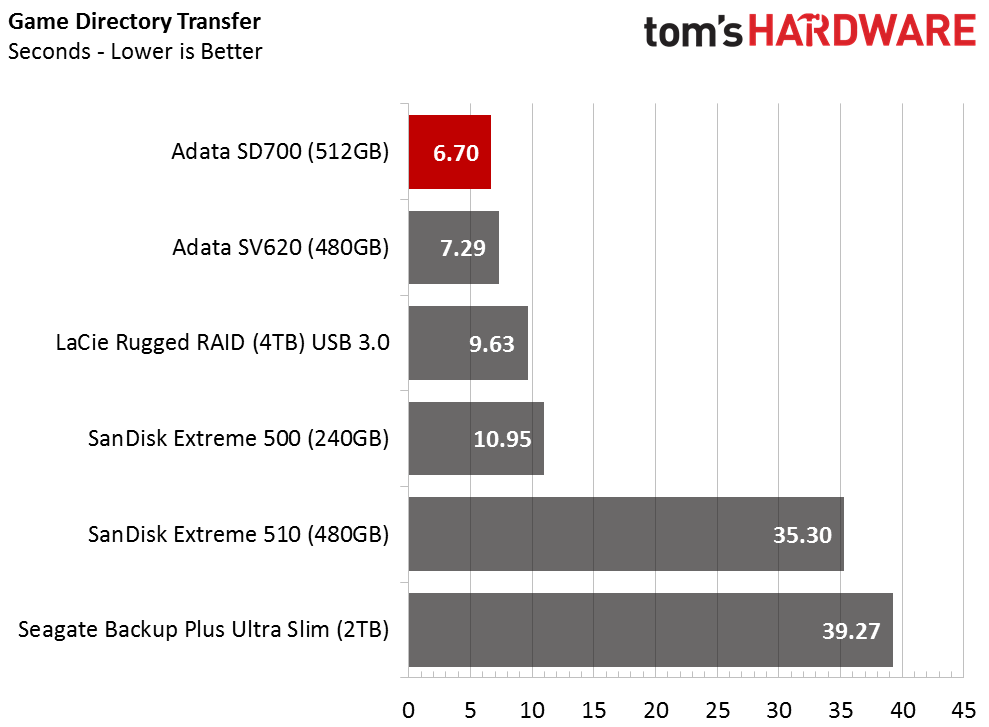

We don't run many synthetic tests on external or portable storage products because the typical workload is sequential in nature. Even though it is possible, users don't run operating systems on these drives, so the typical use case is very basic. Most of us simply read and write large pieces of data for archiving or transferring from one location to another.
We often see performance measured in throughput, but most people would rarely say, "Wow, that transfer was really fast—I bet it was doing at least 150 MB/s." Time-based results are easier to interpret because the sense of time is universal.
We tested with the Avatar (2D + 3D Edition) Blu-ray. We used rFactor from the post-installation directory (C:/Program Files) for the Game directory. The Directory Test is a 15.2GB block of data I modeled for another project several years ago. It comes from a daily-use notebook and contains a mix of images, software installations, ISO files, and multimedia that yields a nice real-world workload.
I'll be the first to admit that the Ultimate SU800 didn't impress me as a boot drive. I haven't been a fan of Micron's 3D TLC, but we've only tested it with 4-channel controllers, and in some cases, only three channels are active because of the odd 384Gbit die. Despite the restrictions, the Adata SD700 is a performance monster with external storage workloads.
We see superior small or large block performance with many of the products in this class, but rarely both. The SD700 is one of the few external storage products that tackles both with the same enthusiasm. Large blocks are easy to write to the drive, and the SD700 brings the magic of a large SLC buffer to handle the often difficult challenge of small data writes.
Conclusion
Flash-based products have slowly moved away from traditional form factors over several years. mSATA, and in more recent times, M.2, have changed the size and shape of many of the products we own. A quick look at many of the popular notebooks confirms that SSDs are not only changing but so are the products we use them in. Most SSDs have a much smaller printed circuit board inside the 2.5-inch case--some are a quarter the size of the housing. At CES, we saw an SSD built into a SATA power and data connector. The drive was the connector, and it was about the same thickness as a stick of gum.
SSDs are rugged by nature. On these very pages, an editor played baseball with an SSD and then used it in a PC afterward without issue. I don't suggest you should take a bat to your drive, but accidents happen. Many of the rugged drives we see protect the printed circuit board and the data path connector. The software is often the main source of SSD failure because they don’t have the heads, platters, or other components of spinning media. The Adata SD700 uses an SMI SM2258 controller with advanced data protection features. The SMI controller has a proven record of reliability, so the internal programming doesn’t concern us.
We will see more flash destined for these secondary markets as costs continue to fall. The SD700 is one of the best low-cost portable SSDs we've tested. The company released several external products, but we consider the SD700 a "round 2" model. The first round of 2016 external SSDs was good, but not great. The SD700 is a great drive.
The SD700 isn't without fault, though. At this point, all external products should ship with a USB Type-C connector. The connector doesn't increase performance, but it does make installing the drive easier. I've never been a fan or enthusiastic about USB micro Type-B connector--and for a good reason; I've broken a handful of them over the years. The failures came from either bending the divider between the two partitions or the leverage you place on the internal solder points. There are more contact points on the PCB, so the connector should be stronger, but that isn't the case. The contact points are very close together, so there is less solder compound than we find with many other external connectors. The connection width allows you to place more force on the fragile solder points, so you end up with a small box of drives that all need a quick reflow to work again. Adata reinforced the connector by butting the plastic housing right up against it. This reduces the amount of force you can place on the connector. With this design, your cable will bend before your SSD does.
It may not seem like much, but only experienced designers add little features like the connector reinforcement. Second-generation products are often better than the initial attempt. The SD700 builds on the experience learned from round one, and we consider it a mature design that doesn't pack any negative surprises that you would only find after the purchase.
MORE: Best SSDs
MORE: How We Test HDDs And SSDs
MORE: All SSD Content

Chris Ramseyer was a senior contributing editor for Tom's Hardware. He tested and reviewed consumer storage.
-
derekullo "This reinforces the USB plug and makes it more difficult to break the connector where it mates with the board inside "Reply
Very colorful wording.
